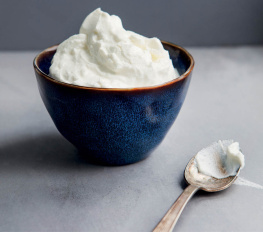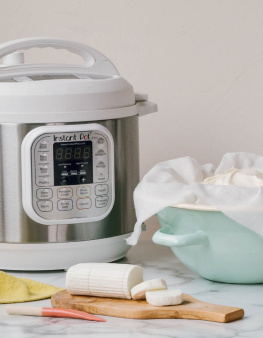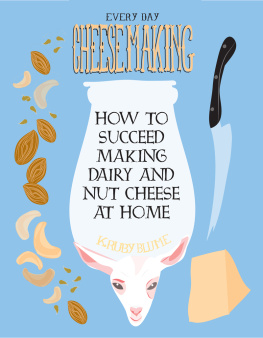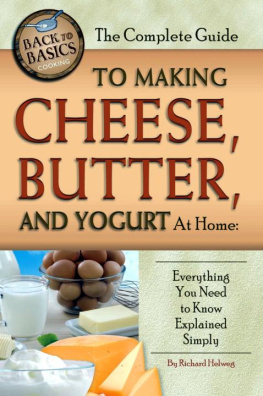THE HOME CREAMERY
THE HOME CREAMERY
KATHY FARRELL-KINGSLEY

The mission of Storey Publishing is to serve our customers by
publishing practical information that encourages
personal independence in harmony with the environment.
Edited by Margaret Sutherland
Art direction and design by Dan O. Williams
Front cover photograph by Susie Cushner Photography
Back cover photographs left to right: Food Collection/Stockfood,
Maximilian StockStockFood Munich/Stockfood,
Michael Grand/Stockfood
Illustrations by Alison Kolesar, with additional decorative art
by Dan O. Williams
Indexed by Christine Lindemer, Boston Road Communications
2008 by Kathy Farrell-Kingsley
All rights reserved. No part of this book may be reproduced without written permission from the publisher, except by a reviewer who may quote brief passages or reproduce illustrations in a review with appropriate credits; nor may any part of this book be reproduced, stored in a retrieval system, or transmitted in any form or by any means electronic, mechanical, photocopying, recording, or other without written permission from the publisher.
The information in this book is true and complete to the best of our knowledge. All recommendations are made without guarantee on the part of the author or Storey Publishing. The author and publisher disclaim any liability in connection with the use of this information. For additional information, please contact Storey Publishing, 210 MASS MoCA Way, North Adams, MA 01247.
Storey books are available for special premium and promotional uses and for customized editions. For further information, please call 1-800-793-9396.
Printed in the United States by CJK
10 9 8 7 6 5 4 3 2 1
Library of Congress Cataloging-in-Publication Data
Farrell-Kingsley, Kathy.
The home creamery / Kathy Farrell-Kingsley.
p. cm.
Includes index.
ISBN 978-1-60342-031-0 (pbk. : alk. paper)
1. Cookery (Dairy products) 2. Dairy products.
3. Cookery (Cheese) 4. Cheese. I. Title.
TX759.F37 2008
637.3dc22
2008005663
INTRODUCTION
SETTING UP YOUR HOME CREAMERY

Theres an old saying that cheese is milks leap toward immortality. And perhaps no one feels more passionately about this adage than those who make their own dairy products and soft cheeses. Its an ancient piece of edible culture that Americans are just now beginning to appreciate.
Home-produced soft, unripened cheeses and dairy products have a wholesome good taste that no shop product can imitate. By making these products at home, youll enjoy a fascinating and very satisfying craft, with a delicious and healthy end result. Its hard to beat the fresh flavor, nutritional value, and low cost of homemade dairy and soft, fresh cheeses.
You dont need a commercial kitchen to produce great-tasting dairy products and fresh, soft cheese at home. Dairy products and most soft cheeses can be made in a matter of hours with equipment that you probably have on hand.
INGREDIENTS
The basis of cheese, of course, is milk, and almost any kind will do. Raw, fresh milk (as opposed to pasteurized) can be used, but it has many more variables to work with, particularly in the handling. Some cheese makers, especially the French, prefer to use raw milk because they credit the naturally occurring bacteria in the raw milk for adding depth of flavor. Raw milk, also known as unprocessed, contains milk fat, which rises to the top as cream. When the milk is processed, most of the cream is removed from the milk. The amount of fat remaining determines the type of milk that is produced, such as whole, low-fat, or skim.
Unless you own cows or goats or are friends with a farmer, its not easy to find raw milk in the United States, though sometimes raw milk is available at farmers markets or at the farms themselves. In most states, its illegal to sell milk raw because of potential contamination. If raw milk is not kept cold enough, bacteria will start to grow and by the time you get to cheese making, it could be curdled and/or contain harmful bacteria. So the key word here is caution: The safest milk to work with is pasteurized, unless you really know what youre doing.
Pasteurization is the process of heating raw milk to at least 145F for at least 30 minutes or to 161F for 15 seconds. The milk is then cooled quickly to 45F or lower. Ultraheat pasteurization involves heating the milk to 274F for 2 to 4 seconds. Ultraheat (UHT) pasteurized milk, however, does not work well for making cheese. The high-heat process affects the whey proteins in the milk, and they will not form curds white, custardlike masses that are firm enough for cheese making and dairy products.
Cheese is made by coagulating, or curdling, milk solids into curds. Curds start off soft, then release liquid called whey as they continue to firm. Using pasteurized milk will give you more control over outcome, and in the end it will result in your cheese making being more successful. Skim and low-fat milk varieties can be used, but keep in mind the end products will be less rich and may have less flavor than cheese made with whole milk or cream.
To make the fresh cheeses and dairy products in this book, you can use cows milk or goats milk or even sheeps milk. Just always purchase the freshest possible and highest quality milk or cream. Whole milk will always work the best because it has the highest butterfat content, but low-fat and skim varieties are given as alternatives for some of the recipes in this book. Goats milk has a slightly higher butterfat content than cows milk, but the butterfat is in smaller globules than that of cows milk. This makes the milk from goats easier to digest and will also produce a soft cheese.
Besides milk, other ingredients that you may need are:
RENNET. Adding rennet causes milk coagulation. Rennet is either animal or vegetable based. It is available in tablet or liquid form and is always diluted with water before use. If the rennet is not diluted it will not distribute evenly in the cheese. Both tablets and liquid come with dilution instructions and strengths but generally are diluted as 3 drops of liquid rennet or tablet to cup of cool water (50 to 65F). Rennet may be purchased from cheese-making supply houses. (See Sources, .)
CULTURES. Cheese cultures are usually divided into two basic groups, thermophilic and mesophilic. Thermophilic is a heat-loving culture. It is used for cheeses that must be heated to a higher temperature, such as mozzarella, Parmesan, or Swiss and Italian-type cheeses. Yogurt is made with a thermophilic culture. Mesophilic is a nonheat-loving culture that would be destroyed at higher temperatures. Its used for 90 percent of cheese making. Buttermilk is made with a mesophilic culture.
Cultures change the milk sugar (lactose) into lactic acid. They can be purchased as a freeze-dried powder that you simply add to the milk when making cheese. Stored in the freezer, cultures last indefinitely. See Sources () for cheese-making supply houses that provide cultures.
EQUIPMENT
You do not need any fancy or expensive equipment to make dairy products and soft cheese at home. The basic equipment youll need includes:

Next page









